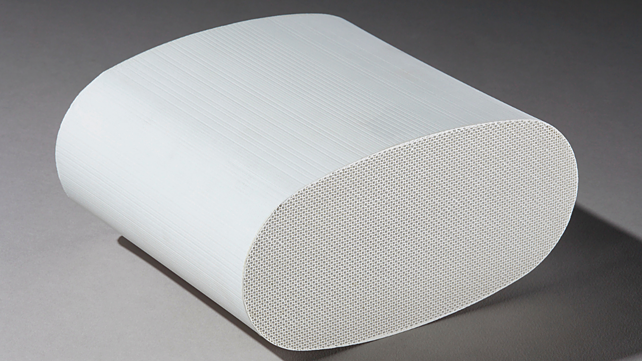
In his current capacity, Dr Willard A Cutler is responsible for the customer-facing technology for Corning’s Environmental Technology business. He has worked for Corning for over 30 years, in various research, product development, commercial, and leadership roles in Europe and the US. He served for eight years on the board of Cormetech Incorporated. Dr Cutler holds a PhD in materials from the University of California, Santa Barbara and a bachelor’s degree in materials science and engineering from the University of Utah. He has been awarded 18 patents and has published a number of scientific papers.
Corning’s first foray into environmental clean-air technologies started with the cellular ceramic substrate four decades back. Talk to us about the innovations in the area of clean air technologies in recent times, and how have they positively impacted the quality of air we breathe?
The cellular ceramic substrate wasn’t really something that was expected to last. The original factory, where the cellular ceramic was developed, which has become the heart of our catalytic converter, was only depreciated over five years because the auto companies said that they would be able to clean their engine sufficiently, and they wouldn't need pollution control devices.
It's really been fascinating to see the extent to which automotive OEMs have been able to clean engines, but the corresponding need to continue to have less and less pollution has resulted in advances in technology.
Typically, with every new regulation the existing technology becomes insufficient to meet the new regulation. We partner and work with OEMs to develop new technologies that then allow us to reduce the gaseous emissions or the particulate emissions that allow for the new regulations. We have a large group of material scientists and process engineers, who then develop the next set of products that can be used as a tool to reduce pollution.
How do you view the transformation in the mobility ecosystem – from ICEs to EVs and other alternate/ greener propulsion technologies in the future?
I think it's a pretty complicated transition particularly for OEMs as they go from pure internal combustion engines to hybrid solutions and then to battery electric vehicles. As all of us are aware, there are a number of challenges with BEVs in terms of the charging infrastructure and range anxiety. But I think, it's a difficult challenge for OEMs because they have to have resources applied to lots of different applications.
It’s an opportunity though to innovate. As an example, on a hybrid vehicle, we have the pollution control devices for a traditional IC engine, as well as the complexity on the electrification side. The challenge is, most of the pollution that occurs in an IC engine happens in the first few minutes. In the case of hybrids, which is turning on and off, the pollution burst happens several times.
The other challenge typically is that hybrids have smaller engines and, with the additional weight of the battery, these engines have to work even harder. So, as we move from pure IC engines to hybrids, we need to make sure that we have the right pollution control devices to be able to control those microbursts of particulates.
None of us know how smoothly this will go. Aspirationally, we would all love to drive BEVs, but I think there are a number of challenges to get from where we are today, to where we'd like to be in the future.

When you look at nations globally, and overall environmental degradation, what are some of the most critical challenges you face in the development of clean air technologies?
The most difficult challenge for us is while everybody's trying to meet, say in a particular region, the same regulations, each OEM, and perhaps each platform at an OEM is at a different starting point. You would like to think that for a particular regulation and a particular region everybody would use the same technology, but in fact, because of their starting points, they all have a different space available in the engine compartment, as well as under the car. They have different requirements in terms of integration and so forth.
So just the complexity of OEM needs, even within a single OEM, could be quite challenging. With that said, India is quite fortunate in that most of the technology needed to meet both current regulations and future regulations has already been invented, because regulations typically cascade from Europe to other parts of the world.
What has been your approach to research, development and innovation? And I would like both a global perspective and a view on your approach for markets such as India, considering the value/ cost conscious mind-set of customers here.
That’s a great question because India is quite unique in terms of a number of things. India has a wide geographic diversity from quite cold in the north to warm in much of the rest of the country. As we think about pollution control, you have the pollution bursts before the car is warmed up. But that gets even more difficult as you go to colder climates or higher elevations. So, being able to deal with the worst case is perhaps the most challenging opportunity.
The US has the tightest gaseous emission requirements and Europe has typically had the tightest particulate emission requirements. On a global basis, the innovations that we start with on the gaseous side are for the US market, and for the particulate side, it's been for Europe. China has been closely following Europe.
When we come to problems in a market like India, we've typically seen and solved these problems for the US, Europe and China market. Our work is to then adapt those technologies to the challenges of the Indian market.
India has an incredibly diverse and different driving cycle. Our approach would typically be to work with the local and global OEMs specifically for the Indian market. We also run our own cars in India, where we put on example technology from the US or Europe and see how does it adapt or how does it behave in the Indian drive cycle and climate.
Based on that insight, we can help the Indian and global OEMs sort out how to adapt the technology to meet the Indian needs. Even from a price point perspective, we need to see how we limit the cost addition that an Indian consumer would have to pay. So it's a little bit tricky, but rewarding to be able to see that sometimes these cars with the new pollution control are actually cleaning the air as they drive through the city.

What are some of the key differences when it comes to cleaner technologies in a developing market vis-à-vis a mature market? Is your approach different?
Fortunately, technologies we’ve developed work in other markets as well – for example, a gasoline particulate filter. We don't think gasoline engines need a filter because we normally don't see particles coming out like you would in a diesel engine. But a number of years ago, the Europeans recognised that even particles that you can't see, small particles that can get deep inside your lungs, can be quite harmful. And so they had proposed a regulation based on particle number to limit the number of particles coming out of even gasoline vehicles.
India is starting to adopt that in a few years, which is a good thing. Europe currently is working on Euro 7 regulations, which will reduce the particulate another 90%. It is then incumbent on us to change the base micro structure in order to capture even more particles. As the need for higher filtration efficiency comes up, we change the microstructure of those walls in order to capture the particles.
Of course, the thing that we don't want to do is make the engine work harder because that is having an effect on both the fuel economy and the power of the vehicle. As a material scientist, it's a fun challenge to be able to capture more and more particles without inhibiting the way the vehicle operates.
How do you see the regulatory scenario emerge in years to come, and what specific requirements do you see coming in?
With the advent of electrification coming, Euro 7 maybe is the last set of regulations in the European market, with China and India following with China 7 and BS 7 respectively. This may provide an opportunity to again decrease the particle output to another order of magnitude. I'm not sure if there will be additional regulations after Euro 7, China 7 or BS 7, based on if the world is really going to electrification or not?
The great thing is we have the technology – regardless of where the regulations go – to meet those regulations. It's just how widely people are willing to go to reduce the amount of pollution.
In the US market, for example, we looked at pollution reduction and chose an aggressive electrification scenario. Today, there's only a few percent of EVs in the US and I suspect it's similar in India. We asked, what if we had 25% BEVs in 2025, which would be pretty aggressive for the US and 100% BEVs in 2040? What would the particulate reduction be as a result of that aggressive electrification?
As we did the analysis, we were a little surprised that even going to 100% BEVs, the reduction in the particulate in tonnes was only about 17%. And that's primarily because our vehicles are built to last for a couple of decades. So, those vehicles sold between now and 2040 are going to be producing emissions for many decades to come.
We saw that it will likely require not only electrification, but continue to provide technologies that reduce particulate emissions. And if we chose both electrification and improving our IC engines, we could reduce the particulate emissions by nearly 50%. I think it creates some challenges for regulators.

Fascinating. What’s your view on the future? How do you think clean air technologies would evolve in the mobility sector in the near to long-term future?
I'm optimistic about the future. We got a little peek of what it's like during the early days of COVID, when fewer people were driving, resulting in clean air. The technology exists to dramatically reduce pollution levels, across all types of IC engines on our path to electrification.
I think there are opportunities and we have to apply these regulations across all vehicles, not pick and choose which vehicles, because unfortunately, all vehicles have some type of pollution. Even with BEVs, the pollution is from the source of where you're generating the electricity, depending on the type of electricity generated.
We have the technology, and it’s a matter of the regulations that are required to be met and what are the costs that consumers are willing to bear to have clean air. We need to look at things holistically and be quite pragmatic about how we approach things.
It's a bright future, but uncertain. We have to prepare for the future. Let's clean up the cars we have today, while we anticipate things in the future.